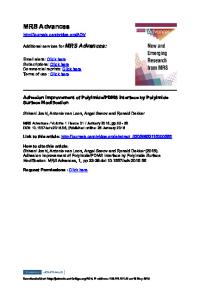Improving Wettability of Feather Fiber by Surface Modification
- PDF / 1,593,848 Bytes
- 11 Pages / 595.276 x 790.866 pts Page_size
- 2 Downloads / 382 Views
ORIGINAL PAPER
Improving Wettability of Feather Fiber by Surface Modification Di Gao1 · Jing Chen1 · Wenzhen Qian1 · Yufeng He1 · Pengfei Song1 · Rongmin Wang1 Received: 30 July 2019 / Accepted: 16 November 2019 © Springer Nature B.V. 2019
Abstract A novel hydrophilic and underwater oleophobic biomass polymer material was synthesized through surface modification using discarded feather fibers from chicken (CF). Firstly, CF fiber was degreased and pretreated by reduction. Then, a silane coupling agent (KH-570) was successfully grafted onto the fiber surface by mercapto-alkenyl click reaction, which afforded hydroxyl modified CF fiber (CF-OH). After being characterized by SEM, FT, and TG, its wetting behavior in different media and absorption capacity of water and oil were investigated, and the effects of pH values and salt were studied as well. It indicated that the wettability of CF fiber was greatly improved after surface modification. The water contact angle (CA) in air reduced from 150.11° to 25.35°, while the CA for underwater in diesel and chloroform reached 134.04° and 143.84°. Compared with raw CF, the wettability of the modified CF-OH in oil–water mixtures was significantly resistant to oil contamination underwater. The underwater wettability of the superhydrophilic feather fiber in the mixture of oil and water was also evaluated. The results demonstrated that the surface wettability of feather is a feasible, environmentally friendly direction of materials. The wetting capacity of CF-OH has been greatly improved.
* Yufeng He [email protected] * Rongmin Wang [email protected] 1
Key Lab. Eco‑Functional Polymer Materials of the Ministry of Education, College of Chemistry and Chemical Engineering, Institute of Polymer, Northwest Normal University, Lanzhou 730070, China
13
Vol.:(0123456789)
Waste and Biomass Valorization
Graphic Abstract
Keywords Discarded chicken feather · Surface modification · Mercapto-alkenyl click reaction · Special wettability
Statement of Novelty
Introduction
As we know, chicken feather is a waste biomass and a natural polymer material containing 90% of keratin, which should be fully used to reduce environmental pollution. Because of the hydrophobicity of the feather fiber, birds can shake off the water from the body easily instead of the oil. Based on this observation, in this study, we have grafted KH-570 onto the surface of feathers through mercapto-alkenyl click reaction to make the feathers hydrophobic in air and oleophobic underwater. The first step of this study is to chemically modify the surface wettability of the discarded feathers using an advanced method. After analyzing the modified materials, the results showed that surface of feather fiber become hydrophilic and oleophobic underwater. Furthermore, the obtained feather fiber materials could be used as low-cost, renewable, and biocompatible material for oil–water separation in the future study.
Poultry meat and eggs provide affordable, good quality food products that are consumed by most ethnic popula
Data Loading...











